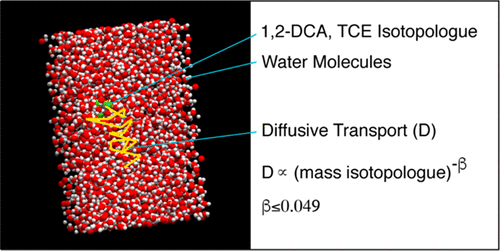当前位置:
X-MOL 学术
›
Environ. Sci. Technol. Lett.
›
论文详情
Our official English website, www.x-mol.net, welcomes your feedback! (Note: you will need to create a separate account there.)
Molecular Dynamic Simulations of Carbon and Chlorine Isotopologue Fractionation of Chlorohydrocarbons during Diffusion in Liquid Water
Environmental Science & Technology Letters ( IF 10.9 ) Pub Date : 2019-10-25 , DOI: 10.1021/acs.estlett.9b00640 Philipp Wanner 1 , Daniel Hunkeler 2
Environmental Science & Technology Letters ( IF 10.9 ) Pub Date : 2019-10-25 , DOI: 10.1021/acs.estlett.9b00640 Philipp Wanner 1 , Daniel Hunkeler 2
Affiliation

|
Until now, the magnitude of isotopologue fractionation of organic compounds due to aqueous-phase diffusion has been quantified only experimentally. This study aims to determine the extent of aqueous-phase diffusion-induced isotopologue fractionation of organic compounds for the first time on a computational basis using molecular dynamic simulations (MDS). The MDS were conducted for different organic compounds including chlorinated ethenes (trichloroethene (TCE)) and ethanes (1,2-dichloroethane (1,2-DCA)) and for different isotopologues (carbon and chlorine). The MDS revealed a weak power law mass (m) dependency of the diffusion coefficient (D ∝ m–β with β ≤ 0.049) for carbon and chlorine isotopologues of TCE and 1,2-DCA, consistent with experimental results. The MDS showed that the mass of the diffusing species is the key controlling factor for diffusion-induced isotopologue fractionation and not the molecular volume as suggested by previous studies. Furthermore, the MDS revealed that the weak power law mass dependency of the diffusive transport rate originates from an interplay between strongly mass-dependent short-term and mass-independent long-term solute–solvent interactions. Hence, the presented MDS results provide for the first a time a theoretical rationale for the experimentally observed magnitude of isotopologue fractionation of organic compounds caused by aqueous-phase diffusion.
中文翻译:

液态水中扩散过程中氯烃碳和氯同位素分馏的分子动力学模拟
迄今为止,由于水相扩散而引起的有机化合物的同位素体分馏的程度仅通过实验进行了量化。这项研究旨在通过分子动力学模拟(MDS),在计算基础上首次确定水相扩散引起的有机化合物同位素同位素分馏的程度。对不同的有机化合物(包括氯化乙烯(三氯乙烯(TCE))和乙烷(1,2-二氯乙烷(1,2-DCA))以及不同的同位素(碳和氯)进行MDS。MDS揭示了扩散系数(D ∝ m –β)的弱幂律质量(m)依赖性TCE和1,2-DCA的碳和氯同位素,β≤0.049),与实验结果一致。MDS显示,扩散物质的质量是扩散诱导的同位素异构体分级分离的关键控制因素,而不是先前研究建议的分子体积。此外,MDS还揭示了扩散速度较弱的幂定律质量依赖性源于强烈的质量相关的短期和质量无关的长期溶质-溶剂相互作用之间的相互作用。因此,本文提出的MDS结果首次为由水相扩散引起的有机化合物的同位素同位素分馏程度的实验观察提供了理论依据。
更新日期:2019-10-25
中文翻译:

液态水中扩散过程中氯烃碳和氯同位素分馏的分子动力学模拟
迄今为止,由于水相扩散而引起的有机化合物的同位素体分馏的程度仅通过实验进行了量化。这项研究旨在通过分子动力学模拟(MDS),在计算基础上首次确定水相扩散引起的有机化合物同位素同位素分馏的程度。对不同的有机化合物(包括氯化乙烯(三氯乙烯(TCE))和乙烷(1,2-二氯乙烷(1,2-DCA))以及不同的同位素(碳和氯)进行MDS。MDS揭示了扩散系数(D ∝ m –β)的弱幂律质量(m)依赖性TCE和1,2-DCA的碳和氯同位素,β≤0.049),与实验结果一致。MDS显示,扩散物质的质量是扩散诱导的同位素异构体分级分离的关键控制因素,而不是先前研究建议的分子体积。此外,MDS还揭示了扩散速度较弱的幂定律质量依赖性源于强烈的质量相关的短期和质量无关的长期溶质-溶剂相互作用之间的相互作用。因此,本文提出的MDS结果首次为由水相扩散引起的有机化合物的同位素同位素分馏程度的实验观察提供了理论依据。



























 京公网安备 11010802027423号
京公网安备 11010802027423号